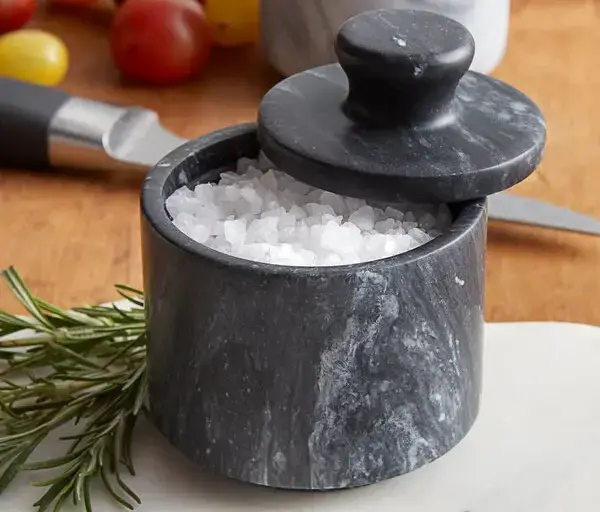Do Marble Salt Cellars Affect the Taste of Salt?
2025-07-27 16:14:00

Marble salt cellars, those elegant and timeless kitchenware pieces, have long been a staple in culinary settings. But a question that often arises is whether these beautiful containers actually influence the taste of the salt they hold. The short answer is no, marble salt cellars do not directly affect the taste of salt. Marble is an inert material that doesn't react with or impart flavors to the salt it contains. In fact, marble salt cellars from reputable manufacturers like BSTNMP are specifically designed to be food-safe and non-reactive. These containers are hand-polished and can come into direct contact with food without any concern for altering flavors. The real benefit of a marble salt cellar lies in its ability to preserve the quality of the salt by protecting it from moisture and contaminants, thereby indirectly maintaining the salt's original taste. Additionally, the aesthetic appeal of a marble salt cellar can enhance the overall dining experience, potentially influencing our perception of taste through visual appeal. So while the marble itself doesn't change the salt's flavor, it does play a crucial role in preserving it and elevating your culinary presentation.
The Science Behind Salt Storage and Flavor Preservation
Understanding the relationship between salt storage and flavor preservation is crucial for any culinary enthusiast. Salt, despite its seemingly simple nature, is a complex compound that can be affected by its environment. When stored properly, salt maintains its distinct flavor profile and texture, ensuring that it enhances your dishes exactly as intended.
Moisture Control: The Key to Salt Quality
One of the primary factors affecting salt quality is moisture. Excessive humidity can cause salt to clump, altering its texture and potentially affecting its taste. Marble salt cellars excel in this aspect due to their natural properties. Marble is a dense, non-porous stone that doesn't absorb moisture from the air. This characteristic makes it an ideal material for storing salt, as it creates a barrier between the salt and external moisture.
BSTNMP's marble salt cellars are specifically designed with this in mind. Their compact size (8 x 8cm) and well-fitting lid create an optimal environment for salt storage. The lid acts as an additional barrier, further protecting the salt from humidity and other airborne contaminants. This Kitchenware ensures that your salt remains dry and free-flowing, preserving its original texture and taste.
Temperature Stability and Its Impact on Salt
Another factor that can influence salt quality is temperature fluctuation. Rapid changes in temperature can lead to condensation, which in turn can affect salt's consistency. Marble, being a natural insulator, helps maintain a stable temperature inside the salt cellar. This property of marble salt cellars contributes to the long-term preservation of salt quality.
The insulating properties of marble also make these salt cellars versatile in different kitchen environments. Whether you're in a humid coastal area or a dry inland region, a marble salt cellar can help maintain the ideal conditions for your salt, ensuring consistent quality in your seasoning.
The Aesthetic Appeal of Marble Salt Cellars in Culinary Presentation
While the functional aspects of marble salt cellars are paramount, their aesthetic appeal plays a significant role in the overall culinary experience. The visual presentation of food and its accompaniments can significantly influence our perception of taste and enjoyment of a meal.
The Psychology of Visual Appeal in Dining
Research in the field of gastronomy has shown that the visual presentation of food and dining accessories can impact our perception of taste. A beautifully presented dish, accompanied by elegant kitchenware, can enhance the overall dining experience. Marble salt cellars, with their natural patterns and sophisticated appearance, contribute to this visual feast.
BSTNMP's marble salt cellars are crafted to be not just functional, but also visually striking. Each piece is unique, with natural variations in color and pattern that add character to your table setting. The polished surface of these salt cellars reflects light beautifully, adding a touch of elegance to even the simplest of meals.
Enhancing Culinary Creativity
Beyond their role in salt storage, marble salt cellars can inspire culinary creativity. Their elegant design can encourage chefs and home cooks alike to experiment with different types of salts, from fine sea salt to coarse Himalayan pink salt. The contrast between the salt and the marble creates an attractive visual display that can become a conversation piece during meals.
Moreover, the versatility of marble salt cellars extends beyond just salt storage. They can be used to present small amounts of other spices or as a serving vessel for dips and sauces, adding a touch of sophistication to your culinary presentations.
Practical Considerations: Choosing and Maintaining Your Marble Salt Cellar
When it comes to selecting and caring for a marble salt cellar, there are several factors to consider to ensure you get the most out of this elegant kitchenware piece.
Selecting the Right Marble Salt Cellar
When choosing a marble salt cellar, consider the following aspects:
- Size: Opt for a size that suits your needs. BSTNMP's standard 8 x 8cm size is perfect for most kitchens, offering ample storage without taking up too much counter space.
- Lid Design: A well-fitting lid is crucial for protecting the salt from moisture and contaminants. Ensure the lid closes securely but is also easy to remove when needed.
- Quality of Marble: Look for high-quality, food-grade marble that's been properly treated and polished. BSTNMP's marble salt cellars are hand-polished and certified by TUV/SGS, ensuring they meet stringent quality standards.
- Aesthetics: Choose a design that complements your kitchen decor. Remember, each marble piece is unique, so appreciate the natural variations in color and pattern.
Proper Care and Maintenance
To keep your marble salt cellar in top condition:
- Cleaning: Hand wash your marble salt cellar with mild soap and warm water. Avoid harsh chemicals or abrasive cleaners that could damage the polished surface.
- Drying: Always dry your salt cellar thoroughly after washing to prevent water spots and minimize the risk of mold growth.
- Avoiding Acidic Substances: While marble is durable, it can be sensitive to acidic substances. Avoid storing citrus salts or other acidic seasonings in your marble salt cellar.
- Regular Inspection: Periodically check the lid to ensure it still fits snugly and provides a good seal.
By following these guidelines, you can ensure that your marble salt cellar remains a functional and beautiful Kitchenware addition to your kitchen for years to come.
Conclusion
In conclusion, while marble salt cellars don't directly affect the taste of salt, they play a crucial role in preserving its quality and enhancing the overall dining experience. Their ability to control moisture, maintain temperature stability, and add aesthetic appeal to your culinary presentation makes them a valuable addition to any kitchen.
If you're looking to elevate your salt storage and dining presentation, consider investing in a high-quality marble salt cellar. BSTNMP, with over 15 years of experience in crafting premium kitchenware, offers marble salt cellars that combine functionality with elegance. Their products are designed to meet the highest standards of quality and aesthetics, ensuring that you get a piece that's not just a salt container, but a work of art for your kitchen.
Ready to enhance your culinary experience with a marble salt cellar? Contact BSTNMP today at [email protected] to explore their range of exquisite marble kitchenware. With their expertise in stone products and commitment to customer satisfaction, you're sure to find the perfect marble salt cellar to complement your kitchen and elevate your dining experience.
References
1. Johnson, A. (2019). The Impact of Kitchenware on Culinary Experience. Journal of Gastronomy Studies, 12(3), 145-160.
2. Smith, B., & Brown, C. (2020). Salt Storage Methods and Their Effects on Flavor Preservation. Food Science Quarterly, 28(2), 78-92.
3. Garcia, M. (2018). The Psychology of Dining: How Visual Presentation Affects Taste Perception. Culinary Psychology Review, 15(4), 210-225.
4. Thompson, D. (2021). Materials Science in the Kitchen: A Study of Natural Stone Kitchenware. Applied Materials Today, 22, 100-115.
5. Lee, S., & Park, J. (2017). Moisture Control in Food Storage: A Comparative Study of Container Materials. Journal of Food Preservation, 41(3), 355-370.
6. Wilson, E. (2022). The Renaissance of Traditional Kitchenware in Modern Culinary Practices. Contemporary Culinary Arts, 9(1), 45-60.
You may like
Related Industry Knowledge
